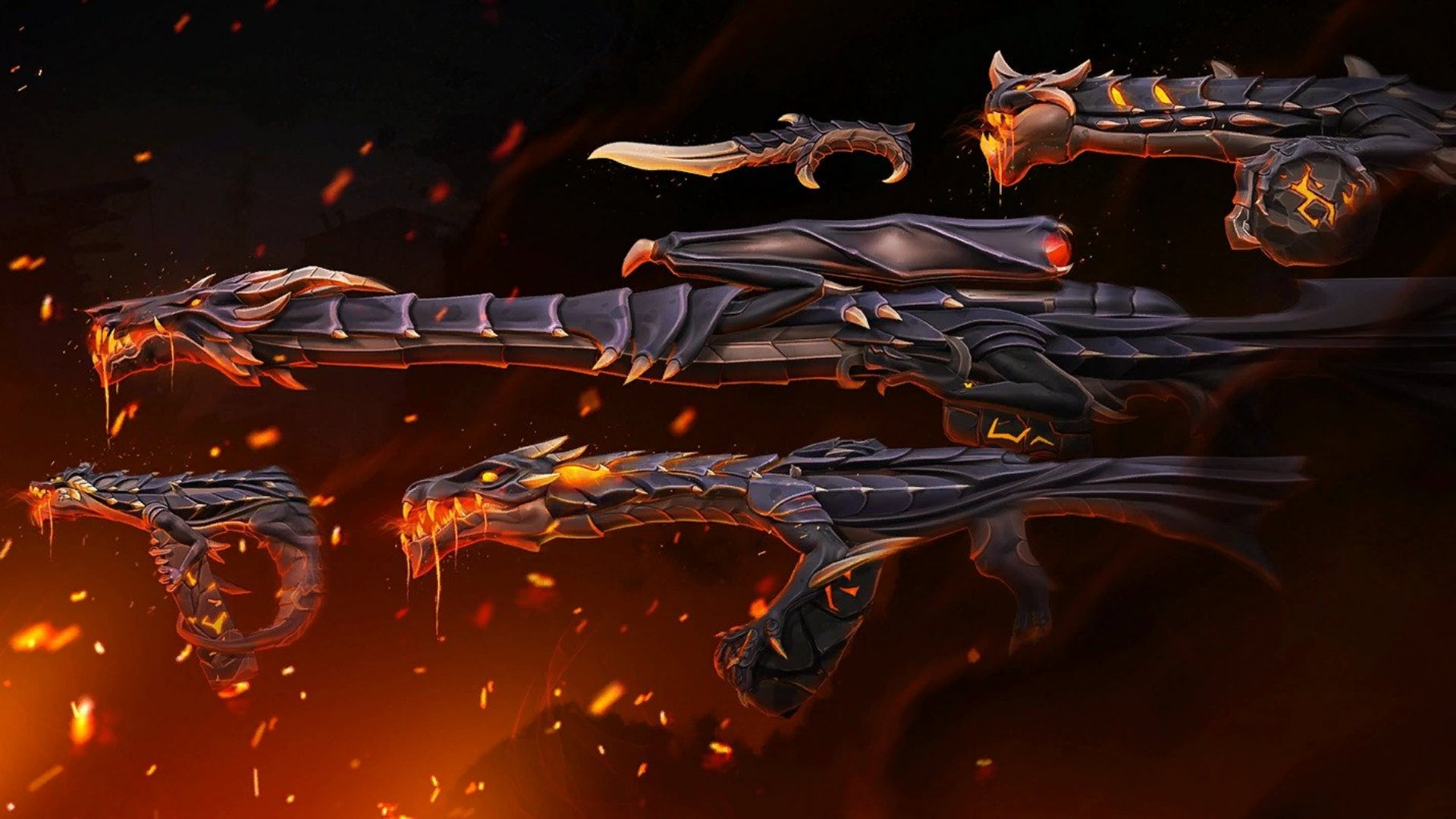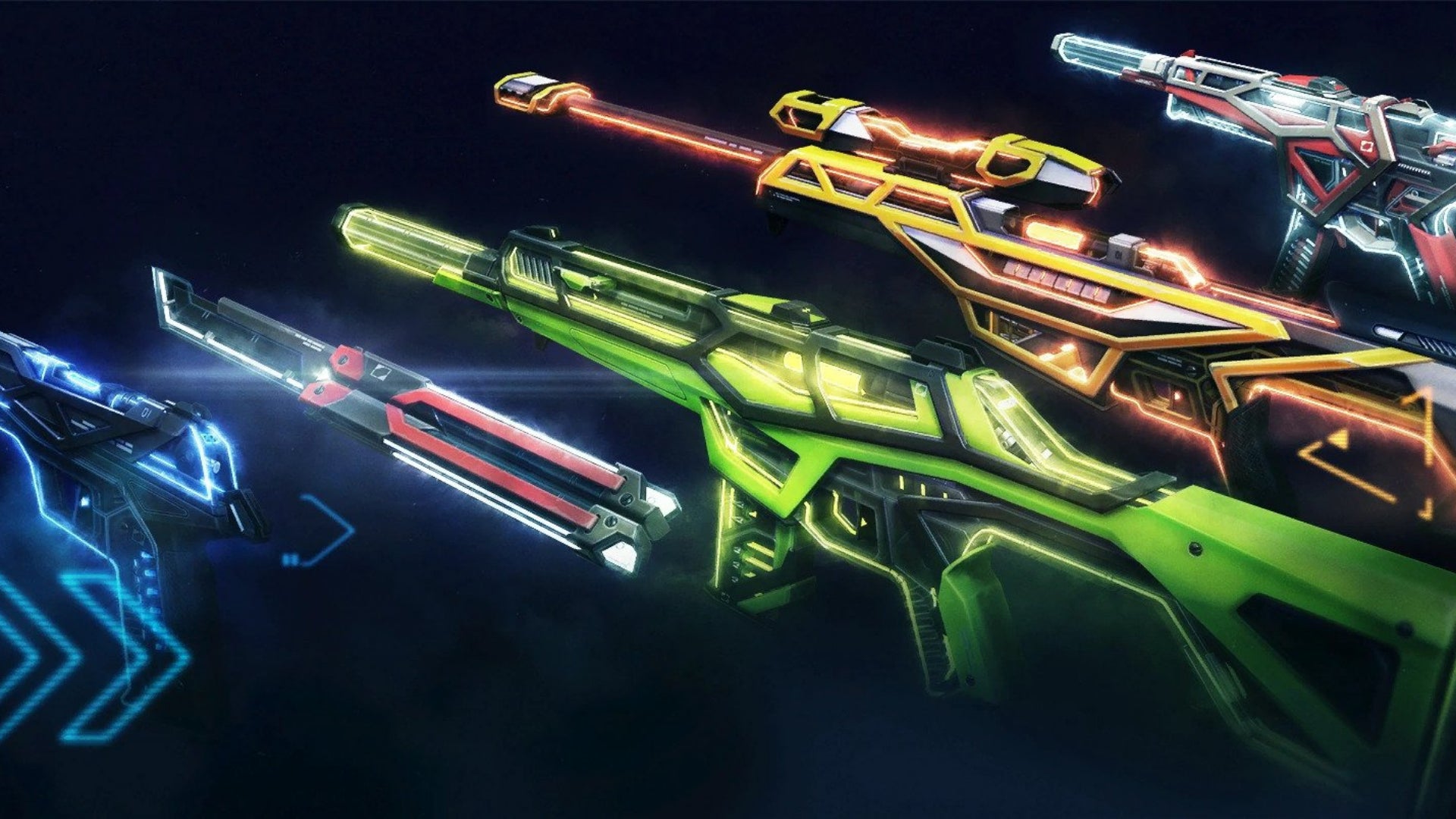Products You May Like
“Every single time I pick up the ‘Elderflame’ skin set, it distracts me. Every single time. I’m a bit of a fanboy for dragons, so, easy serotonin on that front” said one of our interviewees when asked if theh thought skins helped you win a game. “And then I hyperfixate on the skin, and miss every shot, costing a round or sometimes even the game.”
“ALL DRAGON SKINS ARE BAD. DELETE THEM FROM GAME” said another. A pretty bold start to us trying to answer the “are skins pay-to-win” question for Valorant, then.
Valorant is a tactical shooter that pits five attackers against five defenders, bearing similarities to the likes of Counter Strike: Global Offensive and Rainbow Six Siege. As each team tries to either lock down a site or to retake it, players must use a combination of skill, communication, and their characters abilities to secure a win. Whether the power of friendship is on your side or not, the most important aspect of Valorant, arguably, is strategising with your team.
This can prove to be easy for some players, but for others, Valorant becomes an endless cycle of waking up with a winner’s mentality and going to bed tilted. I’m not tilted because of my three competitive losses in a row. I’m tilted over the fact that I spent a heinous amount of money on the RGX 11z Pro skin for my vandal, only to find it to be more detrimental to my gameplay, rather than providing me with the ‘aim bot’ that many Valorant players claims these skins instil you with.
Valorant, as a free to play game, needs to monetise itself somehow. Riot Games does this by rolling out weapon skins and a battle pass regularly. There’s no marketplace like in CS:GO: if you purchase a skin, you’re stuck with it for life. There’s pressure to buy, too, as you can’t scroll through every available skin and take your pick. Instead, Valorant hosts a single storefront with a daily rotation of four random weapons skins unique to every player, and a fortnightly rotation of a new bundle of skins which is the same for every player.
Occasionally (roughly once every two months or so), Valorant also hosts the Night Market: an event that gives every player six random discounted skins to peruse. That’s how I ended up with an Origin operator skin that I hate – I can’t stop inspecting it for that satisfying spinning animation.
Now, what comes to mind when I mention pay-to-win games? And, what if I said Valorant was pay-to-win? Being pay-to-win would imply that players who purchase Valorant skins (the only item in-game that can have an ‘effect’ on actual gameplay aside from Agents themselves) are paying out of pocket for their fancy cosmetics so that they can secure more wins than their counterparts using standard weapons. After all, skins get wins, right?
Well, Valorant is not pay-to-win. Any developer behind cosmetics at Riot Games will likely tell you that (I’m not sure if they could say the same for League of Legends, however). While weapons are loud and flashy, with fun inspection animations, the weapon itself is fundamentally the same for all players, no matter what it looks like. When I reached out to Riot Games’ to ask what it thought on this topic, a spokesperson kindly shared that “even with all the different customizations we have within Valorant, we make sure all content – weapon skins especially – are designed not to interfere with gameplay. While the characteristics of a weapon might change when customized by a skin (model, animation, visual effects, audio), these features are not intended to provide a positive or negative advantage to a player. If we find that any skin does cross this line, know it was accidental and that we will adjust.” I hate to say I told you so, but, I told you so.

Riot’s spokesperson continues: “Additionally, it’s important to note that other players will only see your skin’s model changes. Every other change, from new reload/equip animations, to visual effects and sounds, will only apply to your personal game experience with no impact on other players (i.e. a Vandal with a different skin will always sound like a Vandal to the enemy).” Simply put, no skin is changing your aim, damage output or recoil, and only you see the FX that your weapon skin has.
However, many people – even esports legend, Michael ‘Shroud’ Grzesiek – have held their hands up and made jokes about Valorant’s showiest skins and the possibility of them being pay-to-win.
While it is arguable that the ‘skins get wins’ mentality is just that and nothing more, there’s also no denying how skins act as a positive mental stimulus for the player in some cases. In a tactical shooter like Valorant, I’m a firm believer that your state of mind while playing is just as important as your skill; which means positive mental stimuli can make all the difference between a win and a loss, right?
https://clips.twitch.tv/AstutePrettiestTriangleBIRB-VXPDWy2PyuZj45KQ
While the objective stance is that Valorant skins are not pay-to-win, plenty of players globally will still argue that skins can impact gameplay, and this doesn’t necessarily just apply to Valorant. There are a bunch of silly reasons for this – including getting ‘blinded’ by a shiny skin lying on the floor during a clutch scenario and dying as a result – but there are plenty of well-founded reasons too.
As a result, I decided to survey a bunch of Valorant players’ to see what the community consensus is regarding skins being pay-to-win.
One player, Callum S, said that he logically disagreed with the notion that Valorant skins could be pay-to-win. Although, he did admit that he thinks “it’s possible that certain skins are more distracting for other players,” and he was not alone in thinking this. Reddit user, Axtaze, adds that cosmetics “don’t change anything in terms of movement, gun play, [or] abilities”.
More amusingly, Axtaze continues, “teammates using knife skins always put me at a disadvantage when they swap to their knife every five seconds to show off a skin.” This is something I’m all too familiar with. My friends do it, I do it, I’ve seen professionals do it (albeit not in tournaments). Sometimes, we just really need to spin our RGX Firefly or show off our Celestial Fan, and sometimes, we die as a result. Again, perhaps it’s not the skins we need to blame here, but the players. I’ll hold my hands up for this one, but there’s also no denying that (to some players more than others) some skins can disturb their gameplay.
For a few skins in particular – such as RGX 11z Pro, Reaver, and Prime – multiple players are insistent that they provide you with some sort of ‘aim bot’. More often than not, players stating this are joking, but there are a few who insist it helps. An anonymous player shared that they “used to experience the ‘aim bot’ feeling” with a skin equipped, but the feeling faded away not long after. There’s no proof that this vaguely-defined ‘aim bot’ aura actually improves gameplay, but if I were to make a guess, the positive psychological stimulation of wielding the shiny new skin may have an impact on how you play. Perhaps another anonymous player said it best, saying that any effect that skins do have is nothing more than “just a placebo or selective perception.”
I mean, if you’re dropping £90 on a bundle or even just £45 on a melee weapon, you’re probably going to want to see the benefits, so to speak, even if they are a placebo effect. But, what about all the times that skins might have put your team at a detriment?

A close friend of mine and regular top-fragger in my squad (whenever she can be pulled away from CS:GO) is JQ, who shared with me that “hypothetically, you might be able to get a cheap kill on someone who’s distracted because they have picked up a skin they haven’t seen before, and they’re more focused on that than actually playing.”
At low ranks, this happens more often than not. It’s even possible to bait players by dropping a skin on the ground, in some cases. JQ continues, “I think certain weapons I’ve picked up from enemies have been distracting, to the point where my eyes lean towards the skin as opposed to the gameplay.” When it comes to dealing with a skin they’re not used to, players seem to spend a little too much time pondering over it rather than where the enemies are. This doesn’t make skins fundamentally pay-to-win, though, it just makes them a bit of a nuisance sometimes – primarily at lower ranks and for people less familiar with the game.
Dan, CEO of The Goose House, thinks that sound is the main factor when it comes to skins, alongside firing animations. “I do believe that the sound the weapons make when fired are the leading factor. I think the perfect example is obviously the Prime vandal. It sounds like a laser being fired, when people think of lasers they associate it with pinpoint accuracy, and this may lead them to believe their shots are being more accurate.”
I agree with what Dan says when he notes that weapon cosmetics may lead players to ‘believe’ they’re playing more accurately. This seems to be the running theme amongst most players that I spoke to.
Last but not least, Eden, a Valorant Coach for Guild Academy, raised one incredibly interesting point surrounding skins. “I think certain skins help with tracking your spray pattern,” Eden says, “You can see the tracers of the bullets are different colours on some skins, highlighting them more, which can aid you in distinguishing what you’re doing.” Eden then concluded by saying: “It’s only the same as changing crosshair colour, and besides that and satisfying or differing sounds that someone may not like, skins don’t have much difference.”
That’s great news, for everyone involved. Nobody would want to play a competitive game if they felt their opponents had an advantage in any sense, right? I do, however, think it’s important to keep continually analysing cosmetics in video games. While there isn’t a prevalent issue identifiable right now, we’ve seen the predatory nature of loot boxes in video games arise and how this type of in-game gambling can exploit the most impulsive of players, and it’s important that we move away -from any sort of practice like this that could impact the game itself or player progression.
The consensus across the Valorant community appears to be that how particular weapons ‘feel’ using VFX and SFX can help their gameplay. On the other hand, skins can merely be a distraction from the ongoing game.
Although, the same players often noted that they know there’s nothing more to this than it being purely psychological – most players agree that a purchasable skin in Valorant is not going to give you aim bot skills or make you cracked at the game suddenly (and I say most because some people I spoke with definitely insisted it was a real thing).
That being said, skins in Valorant are not pay-to-win, and while they can impact all players in one way or another, this is no cause for concern across the community. Riot Games, in my humble opinion, has done a great job of letting people show off their unique style and interests in the game without affecting gameplay, and we can only hope that it continues to do so.
